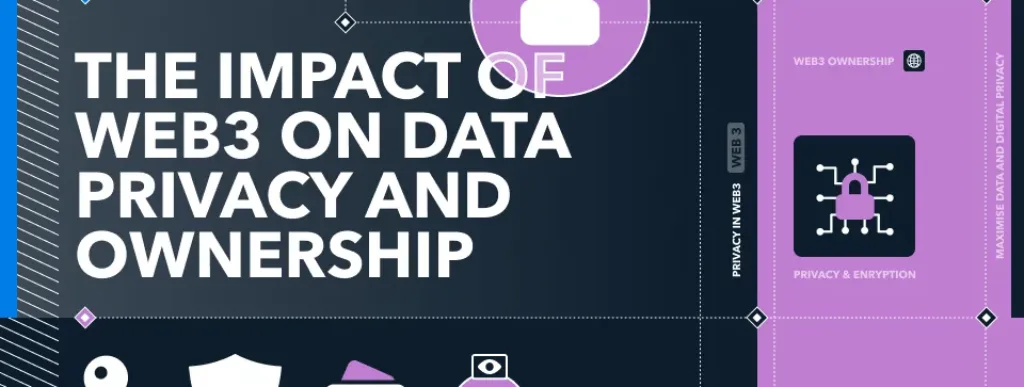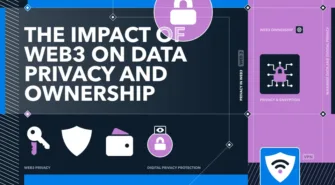Since the second iteration of the web – which we’ll refer to as web2 in contrast to the blockchain-empowered web3 – began to demand more and more data from its users, how that data is used has been a major concern, giving rise to a burgeoning data privacy movement.
As the internet increasingly adopts the latest iteration of the web, web3, it shifts the emphasis back from centralised power structures that store vast quantities of data to individual ownership and control.
Rather than having to trust companies with your data like in web2 (think “Sign in with Google”) there are elements of web3 that are entirely trustless – not requiring a third party facilitator between two parties.
What will change with Web3 privacy and Web3 ownership?
Web3 is making huge changes to how privacy and ownership will work:
Users will have more control over their data. In Web2, data is typically stored and controlled by centralised platforms. This means that users have little control over how their data is used. In Web3, data will be stored on blockchains, which are decentralised networks. This means that users will have more control over who has access to their data and how it is used.
Users will be able to monetize their data. In Web2, users typically give away their data for free. In Web3, users will be able to sell or rent their data to third parties. This will give users a financial incentive to protect their data and control how it is used.
What the ownership economy in Web3 will look like
Here are some specific examples of how Web3 is already being used to improve data privacy and ownership:
– Decentralised Identifiers (DIDs) are a way for users to create unique identifiers that are not tied to any centralised authority. This allows users to control who has access to their data and how it is used.
– Decentralised Applications (DApps) are applications that are built on blockchains. DApps allow users to interact with each other directly, without the need for a centralised intermediary. This can help to protect user privacy and security.
– Privacy-preserving technologies such as zero-knowledge proofs and homomorphic encryption can be used to protect user privacy on Web3. These technologies allow users to share their data without revealing their identity or other sensitive information.
The advent of NFTs have also seen a revolution in provable ownership of assets thanks to the immutable records publicly available on the blockchain. It is entirely possible that in the future, all non-currency items will have NFTs that denote ownership: the deeds to a house, for instance.
In some sectors, such as video gaming, entire ownership economies are supported in web3, including but not limited to metaverses, NFTs, tokens and more.
Not only do individual participants enjoy the benefit of owning their data and assets, some projects transition into DAOs (Decentralised Autonomous Organisations) and are owned by their communities!
How to maximise data and digital privacy protection
Despite the highly-secure nature of blockchain technology, that does not mean scams are not prevalent in the space and unfortunately, bad actors are just as rife in web3 as web2, so here are some specific tips for keeping yourself, your funds and your data secure.
Never share your private keys
Rather than holding personally identifiable data like your email address and password, your Web3 data will be held only by you often in the form of private keys! You must write these down and never ever share them for maximum security. Don’t lose them!
Use a VPN
Using a VPN is an excellent way to hide your IP address and location from malicious actors in both the web2 and web3 spaces.
Don’t connect your wallet to things you don’t trust
The best and safest digital wallets will prompt you before accepting incoming connections from smart contracts, and you should never accept a connection that looks suspicious as these can sometimes drain your account so always check closely!
Check the credibility of projects before getting involved in them
Most credible web3 projects go through a process known as “Doxxing” these days, which involves the previously-anonymous team going public with their identity, past experiences and other relevant credentials to boost potential investor confidence – always check for a “Team” page or section of the whitepaper.
The challenges of privacy in Web3
Whilst the challenges of privacy in web3 should fade over time, they will always be important to consider for savvy investors and first-timers alike. Some of these are:
No “Forgot password” – this useful feature only works because centralised organisations are able to hold so much of your personal information. In web3, where often no data is stored at all, if you’ve lost your private keys, you’ve lost your crypto.
Digital IDs go against the ethos of web3 – whilst blockchains are both public and transparent, they’re also intended to be anonymous. Blockchain’s taking part in Digital ID projects aren’t necessarily staying true to this important ideological factor, which is one of the reasons Bitcoin was created in the first place!
Centralised actors taking over the space and getting hacked – another point of concern that may affect privacy is blockchains such as Ethereum and Polygon increasingly being taken over by private, centralised interests who end up exposing them to additional risks.
For example, the for-profit centralised business Coinbase becoming one of the largest Ethereum validators is not necessarily a good thing for the crypto industry.
As you can see, this is an area that will continue to be important and become even more so over time, but the most important thing to acknowledge is that there are steps individuals can take to protect themselves and their data whilst engaging with web3.
Always check that you actually *own* your investments and they’re not held custodially on your behalf, and ensure that you only share your data with those organisations that you trust.
This publication is for informational purposes only and is not intended to be a solicitation, offering or recommendation of any security, commodity, derivative, investment management service or advisory service and is not digital asset or cryptocurrency trading advice. This publication does not intend to provide investment, tax or legal advice on either a general or specific basis.



